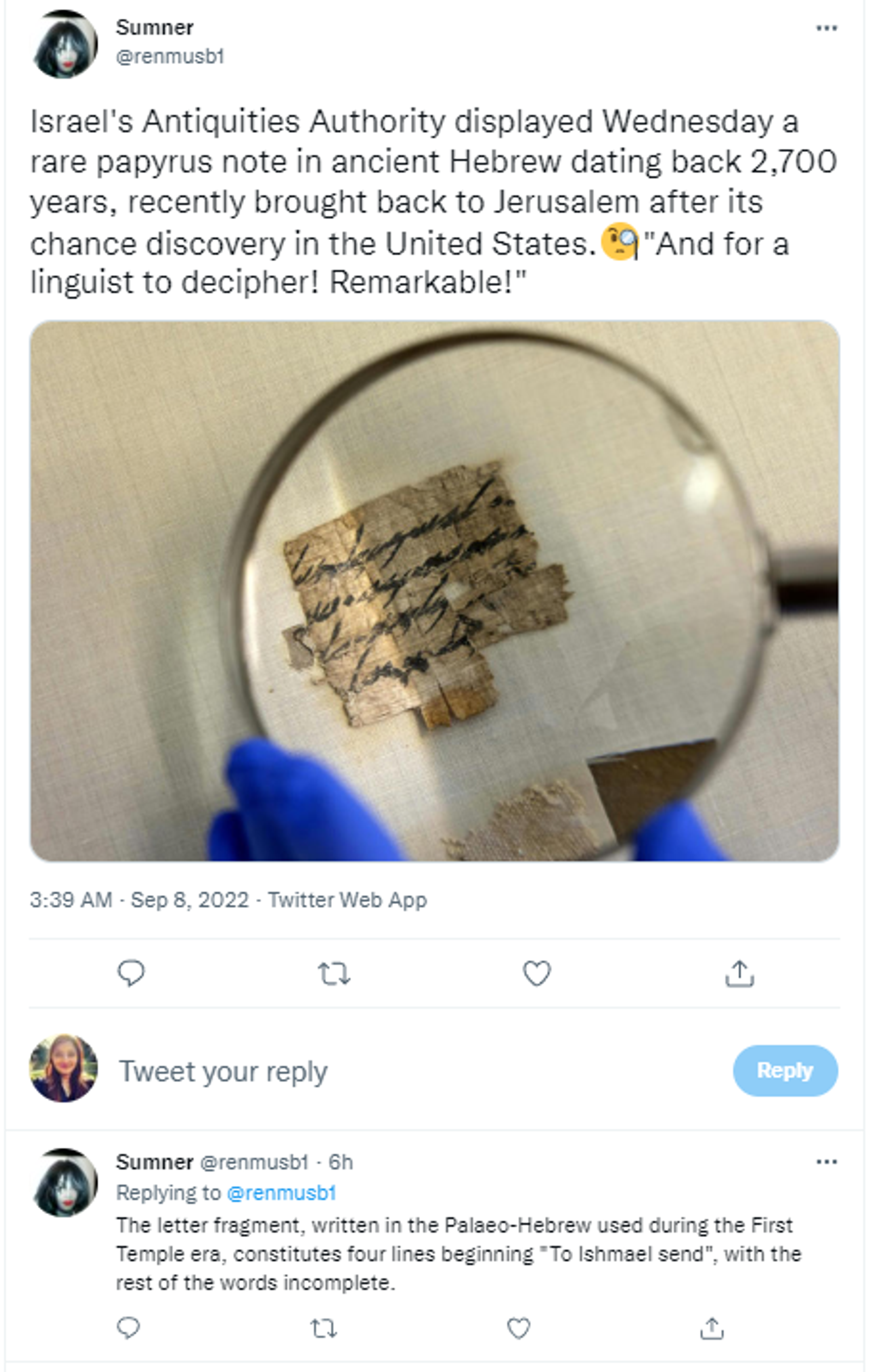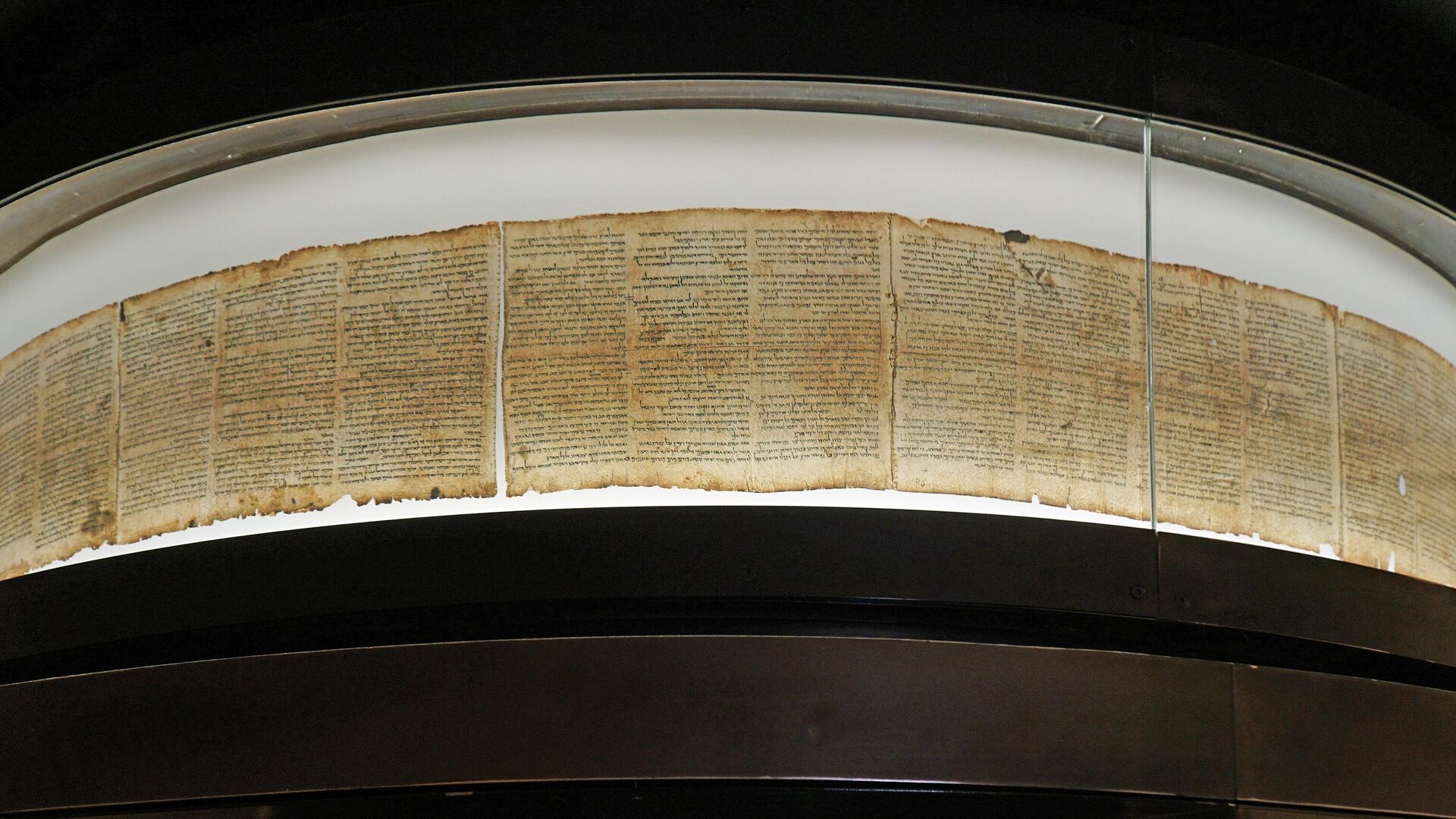https://sputnikglobe.com/20220908/2700-year-old-extremely-rare-iron-age-papyrus-note-unveiled-in-israel-1100524644.html
2,700-Year-Old 'Extremely Rare' Iron Age Papyrus Note Unveiled in Israel
2,700-Year-Old 'Extremely Rare' Iron Age Papyrus Note Unveiled in Israel
Sputnik International
Through paleographic and carbon-14 dating methods, researchers determined the exact era and historicity of the papyrus note, written in the Paleo-Hebrew... 08.09.2022, Sputnik International
2022-09-08T14:46+0000
2022-09-08T14:46+0000
2025-04-07T11:04+0000
jerusalem
israel
iron age
discovery
letter
viral news
https://cdn1.img.sputnikglobe.com/img/07e6/09/08/1100552136_0:172:3027:1875_1920x0_80_0_0_1027cbe29151e0c3baf6e3ec287ecd95.jpg
A 2,700-year-old papyrus note has been unveiled by Israel's Antiquities Authority. It was found in the US and brought back to Jerusalem recently.The letter fragment on the note reads: “To Ishmael send.”Discussing the message communicated through the letter, Joe Uziel, director of the Antiquities Authority's Judaean Desert scrolls unit, told AFP: "We don't know exactly what was being sent and to where."Calling the recently discovered papyrus note "unique and extremely rare," Eaton Klein, deputy director of the Theft Prevention Unit, explained that during the Iron Age, Hebrews used pieces of clay to write down small notes.While animal hide (skins) were used for scriptures, papyrus (a material similar to thick paper used in ancient times as a writing surface) was reserved for official correspondence. The researchers reportedly recovered the papyrus note from a man in the US state of Montana. He acquired it from his late mother, who had framed it and hung it in her home.The framed papyrus note also had pictures of Joseph Saad, the curator of the then-Palestine Archaeological Museum, and legendary Bethlehem antiquities dealer Halil Iskander Kandu.It is said that in 1965, the woman may have purchased or received the papyrus note as a gift from Saad who, in turn, had obtained it from Kandu.According to Klein's investigation, Kandu most likely bought it from a Bedouin tribe who found it in a Judaean Desert cave in Israel.
jerusalem
israel
Sputnik International
feedback@sputniknews.com
+74956456601
MIA „Rossiya Segodnya“
2022
Sangeeta Yadav
https://cdn1.img.sputnikglobe.com/img/07e4/08/1b/1080292803_0:121:960:1081_100x100_80_0_0_7490b319dab9611e309056b177265184.jpg
Sangeeta Yadav
https://cdn1.img.sputnikglobe.com/img/07e4/08/1b/1080292803_0:121:960:1081_100x100_80_0_0_7490b319dab9611e309056b177265184.jpg
News
en_EN
Sputnik International
feedback@sputniknews.com
+74956456601
MIA „Rossiya Segodnya“
Sputnik International
feedback@sputniknews.com
+74956456601
MIA „Rossiya Segodnya“
Sangeeta Yadav
https://cdn1.img.sputnikglobe.com/img/07e4/08/1b/1080292803_0:121:960:1081_100x100_80_0_0_7490b319dab9611e309056b177265184.jpg
jerusalem, israel, iron age, discovery, letter, viral news
jerusalem, israel, iron age, discovery, letter, viral news
2,700-Year-Old 'Extremely Rare' Iron Age Papyrus Note Unveiled in Israel
14:46 GMT 08.09.2022 (Updated: 11:04 GMT 07.04.2025) Through paleographic and carbon-14 dating methods, researchers determined the exact era and historicity of the papyrus note, written in the Paleo-Hebrew language.
A 2,700-year-old papyrus note has been unveiled by Israel's Antiquities Authority. It was found in the US and brought back to Jerusalem recently.
The letter fragment on the note reads: “To Ishmael send.”
Discussing the message communicated through the letter, Joe Uziel, director of the Antiquities Authority's Judaean Desert scrolls unit, told AFP: "We don't know exactly what was being sent and to where."
Calling the recently discovered papyrus note "unique and extremely rare," Eaton Klein, deputy director of the Theft Prevention Unit, explained that during the Iron Age, Hebrews used pieces of clay to write down small notes.
While animal hide (skins) were used for scriptures, papyrus (a material similar to thick paper used in ancient times as a writing surface) was reserved for official correspondence.
The researchers reportedly recovered the papyrus note from a man in the US state of Montana. He acquired it from his late mother, who had framed it and hung it in her home.
The framed papyrus note also had pictures of Joseph Saad, the curator of the then-Palestine Archaeological Museum, and legendary Bethlehem antiquities dealer Halil Iskander Kandu.
It is said that in 1965, the woman may have purchased or received the papyrus note as a gift from Saad who, in turn, had obtained it from Kandu.
According to Klein's investigation, Kandu most likely bought it from a Bedouin tribe who found it in a Judaean Desert cave in Israel.



